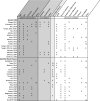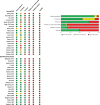Towards the best kidney failure prediction tool: a systematic review and selection aid
- PMID: 30830157
- PMCID: PMC7473808
- DOI: 10.1093/ndt/gfz018
Towards the best kidney failure prediction tool: a systematic review and selection aid
Abstract
Background: Prediction tools that identify chronic kidney disease (CKD) patients at a high risk of developing kidney failure have the potential for great clinical value, but limited uptake. The aim of the current study is to systematically review all available models predicting kidney failure in CKD patients, organize empirical evidence on their validity and ultimately provide guidance in the interpretation and uptake of these tools.
Methods: PubMed and EMBASE were searched for relevant articles. Titles, abstracts and full-text articles were sequentially screened for inclusion by two independent researchers. Data on study design, model development and performance were extracted. The risk of bias and clinical usefulness were assessed and combined in order to provide recommendations on which models to use.
Results: Of 2183 screened studies, a total of 42 studies were included in the current review. Most studies showed high discriminatory capacity and the included predictors had large overlap. Overall, the risk of bias was high. Slightly less than half the studies (48%) presented enough detail for the use of their prediction tool in practice and few models were externally validated.
Conclusions: The current systematic review may be used as a tool to select the most appropriate and robust prognostic model for various settings. Although some models showed great potential, many lacked clinical relevance due to being developed in a prevalent patient population with a wide range of disease severity. Future research efforts should focus on external validation and impact assessment in clinically relevant patient populations.
Keywords: kidney failure; prediction model; prognostic; systematic review.
© The Author(s) 2019. Published by Oxford University Press on behalf of ERA-EDTA.
Figures





References
Publication types
MeSH terms
LinkOut - more resources
Full Text Sources
Medical

